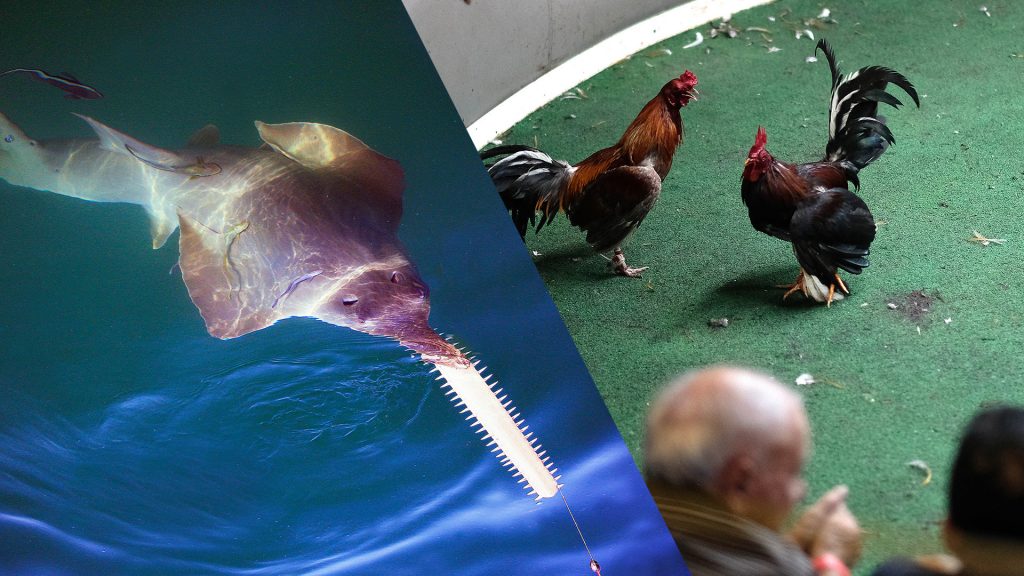Peru’s cockfighters may impact survival of endangered largetooth sawfish
Ella Greene March 28, 2025 0
- The survival of the critically endangered largetooth sawfish, once common along Peru’s northern coast, could be influenced by the country’s cockfighters. The animals’ rostral teeth have been highly valued in Peruvian cockfighting circles, where they are polished into spurs worn by roosters.
- In 2000, some Peruvian cockfighting leagues prohibited the use of animal-based spurs, citing efforts to protect sawfish populations, but the enforcement of these bans remains a challenge.
- Local advocates are increasing outreach efforts to educate those in Peru’s cockfighting industry about the importance of protecting the largetooth sawfish through presentations at conventions and awareness campaigns in arenas.
Full Story
The critically endangered largetooth sawfish faces mounting threats that are pushing it closer to extinction. Once common along Peru’s northern coast, the survival of this species could now be influenced by the country’s cockfighting industry.
What is a largetooth sawfish?
Capable of growing up to 23 feet long, the largetooth sawfish is a type of ray with a shark-like body and an elongated, chainsaw-shaped snout. However, this species has experienced a drastic population decline due to habitat destruction, accidental capture, and the illegal trade of its body parts.
How could Peruvian cockfighters influence the largetooth sawfish’s survival?
A key driver of this illegal trade is the demand for the animals’ rostral teeth, which have been highly valued in Peruvian cockfighting circles. For decades, cockfighters have sought out these teeth to be polished into spurs worn by roosters during matches. While cockfighting is illegal in the United States, it remains a legal and culturally significant practice in Peru.
Between 2016 and 2017, researchers surveyed 49 Peruvian cockfighters, more than half of whom said they had purchased largetooth sawfish spurs at least once in the preceding five years. However, growing awareness of the species’ endangered status has led to conservation efforts, which in some cases were actually implemented within the cockfighting community before the Peruvian government took action.
What is being done in Peru to save the largetooth sawfish?
In response to calls from environmental groups, Peru’s Ministry of Production banned the capture, transport, and sale of largetooth sawfish and its body parts in 2020. Even before this, certain Peruvian cockfighting leagues had prohibited the use of animal-based spurs in 2000, citing efforts to protect both sawfish populations and roosters, which sustain less serious injuries when equipped with artificial spurs.
Despite these regulatory measures, enforcement remains a challenge. Illegal sales of largetooth sawfish spurs persist, with products still appearing on online marketplaces. Local Peruvian fishermen also report continued demand for sawfish teeth, further complicating conservation efforts.
What happens next?
To combat this, local advocates have intensified outreach efforts, attempting to educate those involved in Peru’s cockfighting industry on the ecological importance of protecting the largetooth sawfish. These initiatives include presentations at cockfighting conventions and awareness campaigns in arenas.
Marine conservationists emphasize that while habitat loss plays a more significant role in the species’ decline, the rarity of the largetooth sawfish means that addressing all contributing threats—including the illegal trade tied to cockfighting—remains crucial to its survival.
Related Stories
Ella Rae Greene, Editor In Chief
Ella Greene
Ella and the staff at Clear Media Project (CMP) curate these articles.
Unless otherwise noted CMP does not write these articles.
The views, thoughts, and opinions expressed in the articles published on this blog belong solely to the original authors and do not necessarily reflect the views of the blog owner. The blog owner does not claim ownership of the content shared by contributors and is not responsible for any inaccuracies, errors, or omissions.
All rights and credits goes to its rightful owners. No Copyright Infringement is intended. If you believe any content infringes on your rights, please contact us for review and potential removal.





